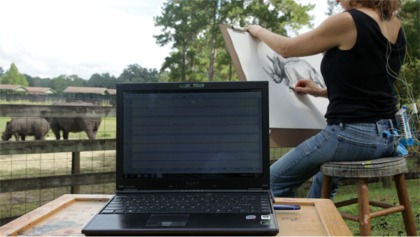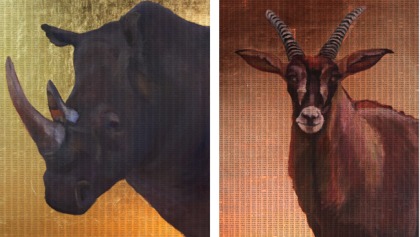|
Electroencephalogram (The EEG Project)
|
Each day at White Oak was an adventure. Left alone to paint, I stood in the midst of creatures I hadn't
known to exist: giant eland, eastern bongo, the velvety rainforest giraffe, the okapi, and my personal favorite, the prehistoric-looking
claw footed cassowary. As an artist, my mind often becomes filled with an idea or image and I obsessively work toward realizing
it. What I felt while painting the endangered species at White Oak was much stronger than the hand of inspiration. In the
presence of these animals, I began feeling as though my brain had been blanketed by a cosmic sense of well-being.
|
|

|
The billions of nerve cells in the human brain produce small electrical signals that form patterns
called brain waves. During an EEG, numerous electrodes are affixed to the skull, recording the electrical activity from the
different parts of the brain. The differing electrical signals can be used to localize what area of the brain is being affected.
In addition, different states of mind are associated with differing dominant wave patterns. I described
my project of painting these endangered species and my feelings of euphoria to a prominent neurologist at UCLA who is an expert
in interpreting EEGs. There are numerous laboratory studies on the brains of "creative" people, but we wondered
if we could look at the brain during the actual creative process. Together we came up with a plan. Since motor movement affects
brainwaves, our study would require me to take a break from painting every 8 minutes, close my eyes and stay motionless for
1 minute. We would look at those periods of inactivity to analyze any brainwave changes. Our goal was to try to locate the
primordial region of the brain which was stimulated by the observation and visual depiction of animals - the same area that
inspired early humans to pick up charcoal and pigment and cover cave wall after cave wall in perpetuity.
|
|

|
With the help of a technician, and much tape to keep the electrodes attached to my head for several
days, we did a number of EEG readings in the field while I sketched and painted the animals. Each study was captured on a
computer with software that translated the EEG readings into 64,000 lines of numbers. Here we could see actual numbers –
hard scientific data that represents my inner emotions from a personal interaction at a specific time and place. Inspired
by my residency and research I created a series of giclée prints. I lay the EEG readings' raw numbers over my animal
portraits as an homage to the early cave painters who so often left a series of handprints next to their animal images. These
readings of my brain are my handprints - unique to me, but also a reflection of the ancient bond that links humans to animals,
and the origin of our impulse to create.
|
|
